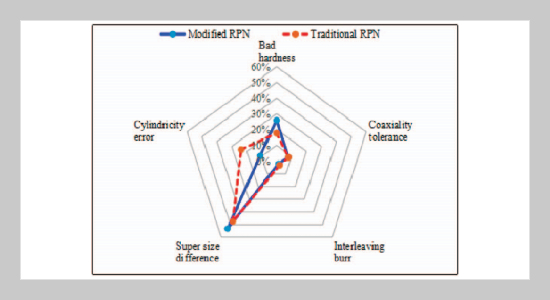REFERENCES
- [1] Bowles, J. B. and Peláez, C. E., “Fuzzy Logic Prioritization of Failures in a System Failure Mode, Effects and Criticality Analysis,” Reliability Engineering and System Safety, Vol. 50, No. 2, pp. 203213 (1995). doi: 10.1016/0951-8320(95)00068-D.
- [2] Su, X. Y., Deng, Y., Mahadevan, S. and Bao, Q. L., “An Improved Method for Risk Evaluation in Failure Modes and Effects Analysis of Aircraft Engine Rotor Blades,” Engineering Failure Analysis, Vol. 26, pp. 164174 (2012). doi: 10.1016/j.engfailanal.2012.07. 009
- [3] Chang, K. H. and Cheng, C. H., “Evaluating the Risk of Failure Using the Fuzzy OWA and DEMATEL Method,” Journal of Intelligent Manufacturing, Vol. 22, pp. 113129 (2011). doi: 10.1007/s10845-009- 0266-x
- [4] Arabian-Hoseynabadi, H., Oraee, H. and Tavner, P. J., “Failure Modes and Effects Analysis (FMEA) for Wind Turbines,” Electrical Power and Energy Systems, Vol. 32, No. 7, pp. 817824 (2010). doi: 10.1016/j.ijepes. 2010.01.019
- [5] Silveira, E., Atxaga, G. and Irisarri, A. M., “Failure Analysis of Two Sets of Aircraft Blades,” Engineering Failure Analysis, Vol. 17, No. 3, pp. 641647 (2010). doi: 10.1016/j.engfailanal.2008.10.015
- [6] Liu, H. C., Liu, L., Liu, N. and Mao, L. X., “Risk Evaluation in Failure Mode and Effects Analysis with Extended VIKOR Method under Fuzzy Environment,” Expert Systems with Applications, Vol. 39, No. 7, pp. 1292612934 (2012). doi: 10.1016/j.eswa.2012.05.031.
- [7] Zhang, Z. F. and Chu, X. N., “Risk Prioritization in Failure Mode and Effects Analysis under Uncertainty,” Expert Systems with Applications, Vol. 38, No. 1, pp. 206214 (2011). doi: 10.1016/j.eswa.2010.06.046
- [8] Zammori, F. and Gabbrielli, R., “ANP/RPN: A Multi Criteria Evaluation of the Risk Priority Number,” Quality and Reliability Engineering International, Vol. 28, No. 1, pp. 85104 (2012). doi: 10.1002/qre.1217
- [9] Kutlu, A. C. and Ekmekçiolu, M., “Fuzzy Failure Modes and Effects Analysis by Using Fuzzy TOPSISbased Fuzzy AHP,” Expert Systems with Applications, Vol. 39, No. 1, pp. 6167 (2012). doi: 10.1016/j.eswa. 2011.06.044
- [10] Keskin, G. A. and Özkan, C., “An Alternative Evaluation of FMEA: Fuzzy ART Algorithm,” Quality and Reliability Engineering International, Vol. 25, No. 6, pp. 647661 (2009). doi: 10.1002/qre.984
- [11] Liu, H. C., You, J. X., Shan, M. M. and Shao, L. N., “Failure Mode and Effects Analysis Using Intuitionistic Fuzzy Hybrid TOPSIS Approach,” Soft Computing, Vol. 19, No. 4, pp. 10851098 (2015). doi: 10. 1007/s00500-014-1321-x
- [12] Mandal, S. and Maiti, J., “Risk Analysis Using FMEA: Fuzzy Similarity Value and Possibility Theory Based Approach,” Expert Systems with Applications, Vol. 41, No. 7, pp. 35273537 (2014). doi: 10.1016/j.eswa.2013. 10.058
- [13] Wang, Y. M., Chin, K. S., KaKwaiPoon, G. and Yang, J. B., “Risk Evaluation in Failure Mode and Effects Analysis Using Fuzzy Weighted Geometric Mean,” Expert Systems with Applications, Vol. 36, No. 2, pp. 11951207 (2009). doi: 10.1016/j.eswa.2007.11.028
- [14] Hu, A. H., Hsu, C. W., Kuo, T. C. and Wu, W. C., “Risk Evaluation of Green Components to Hazardous Substance Using FMEA and FAHP,” Expert Systems with Applications, Vol. 36, No. 3, pp. 71427147 (2009). doi: 10.1016/j.eswa.2008.08.031
- [15] Xu, K., Tang, L. C., Xie, M., Ho, S. L. and Zhu, M. L., “Fuzzy Assessment of FMEA for Engine Systems,” Reliability Engineering and System Safety, Vol. 75, No. 1, pp. 1729 (2002). doi: 10.1016/S0951-8320 (01)00101-6
- [16] Zadeh, L. A., “Fuzzy Sets,” Information and Control, Vol. 8, No. 3, pp. 338353 (1965). doi: 10.1016/ S0019-9958(65)90241-X
- [17] Laarhoven, P. J. M. and Pedrycz, W., “A Fuzzy Extension of Saaty’s Priority Theory,” Fuzzy Sets and Systems, Vol. 11, pp. 229241 (1983). doi: 10.1016/ S0165-0114(83)80082-7
- [18] Kaufmann, A. and Gupta, M. M., “Fuzzy Mathematical Models in Engineering and Management Science,” Amsterdam: North Holland, pp. 121122 (1988).
- [19] Xiao, Y. and Lee, H., “Improvement on Judgment Matrix Based on Triangle Fuzzy Number,” Fuzzy Systems and Mathematics, Vol. 17, pp. 5964 (2003).
- [20] Saaty, T. L., The Analytic Hierarchy Process, McGrawHill, New York (1980).
- [21] Abdullah, L. and Zulkifli, N., “Integration of Fuzzy AHP and Interval Type-2 Fuzzy DEMATEL: an Application to Human Resource Management,” Expert Systems with Applications, Vol. 42, No. 9, pp. 43974409 (2015). doi: 10.1016/j.eswa.2015.01.021
- [22] Hosseini Ezzabadi, J., Saryazdi, M. D. and Mostafaeipour, A., “Implementing Fuzzy Logic and AHP into the EFQM Model for Performance Improvement: a Case Study,” Applied Soft Computing, Vol. 36, pp. 165176 (2015). doi: 10.1016/j.asoc.2015.06.051
- [23] Buckley, J. J., “Fuzzy Hierarchical Analysis,” Fuzzy Sets and Systems, Vol. 17, No. 3, pp. 233247 (1985). doi: 10.1016/0165-0114(85)90090-9
















